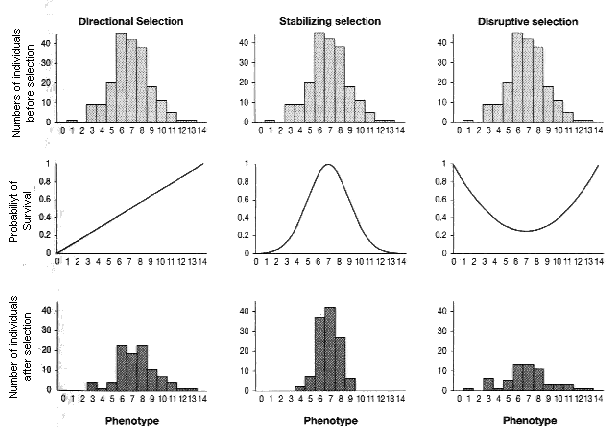
Modes of Natural Selection
For a
trait influenced by multiple gene loci with approximately
equal, additive effect, the trait
distribution will approximate a normal
distribution (bell curve). Such a trait is
measured over an arbitrary scale of 1-14 units (top
row). The probability
of survival follows a fitness
function that varies over the range of
phenotypes [middle row]. As a result, the
trait distribution after selection is
modified in a (statistically) predictable manner
[bottom row]. The change in trait distribution can be
described in terms of the effect on mean and variance.
Under Directional Selection (left), the trait mean is shifted (here, it increases), and the variance is skewed (unbalanced towards the left or right tail (as shown here)) over the course of a single generation. Variation in the offspring generation will be normal around the new mean, with the same variance. Under Stabilizing Selection (middle), both tails are truncated. The trait mean remains constant, but the trait variance is reduced. Under Disruptive Selection, both tails are favored at the expense of the modal phenotypes. The trait mean remains constant, but the trait variance is increased. [The technical descriptions of the distributions after stabilizing and disruptive selection are leptokurtotic ("pointed") and platykurtotic ("flattened"), respectively'].
The fitness function for directional selection is shown as a straight line between 0.0 and 1.0: this is unrealistic. Except for medical conditions involving lethality, fitness differences across trait distributions tend to be small, < or << 0.01, which means they are difficult to measure, and will affect evolution very slowly. As well, the criterion for directional selection is a fitness function with a positive slope, but no necessarily a constant positive slope as in the example. The fitness function for stabilizing selection is somewhat more realistic, if trait variation around the mean consistent with viability is small (consider body weight in newborns). Note that the fitness function is initially positive, flattens at the optimum, and is negative thereafter. The criterion for disruptive selection is the reverse of this, negative, then flat at the minimum, then positive. Disruptive selection may facilitate local adaptation, if the optimal trait value varies over the range of a species. In principle, disruptive selection can accompany speciation, for example if the trait extremes are for aspects of mating behavior (Darwin recognized "Sexual Selection").
Selection in each case ensures that the genetic composition of the next generation is modified. This is most easily appreciated in the case of directional selection, where allele(s) at each locus that increase the trait measure are favored by selection: the frequency of those alleles will be increased in next generation.
Under Directional Selection (left), the trait mean is shifted (here, it increases), and the variance is skewed (unbalanced towards the left or right tail (as shown here)) over the course of a single generation. Variation in the offspring generation will be normal around the new mean, with the same variance. Under Stabilizing Selection (middle), both tails are truncated. The trait mean remains constant, but the trait variance is reduced. Under Disruptive Selection, both tails are favored at the expense of the modal phenotypes. The trait mean remains constant, but the trait variance is increased. [The technical descriptions of the distributions after stabilizing and disruptive selection are leptokurtotic ("pointed") and platykurtotic ("flattened"), respectively'].
The fitness function for directional selection is shown as a straight line between 0.0 and 1.0: this is unrealistic. Except for medical conditions involving lethality, fitness differences across trait distributions tend to be small, < or << 0.01, which means they are difficult to measure, and will affect evolution very slowly. As well, the criterion for directional selection is a fitness function with a positive slope, but no necessarily a constant positive slope as in the example. The fitness function for stabilizing selection is somewhat more realistic, if trait variation around the mean consistent with viability is small (consider body weight in newborns). Note that the fitness function is initially positive, flattens at the optimum, and is negative thereafter. The criterion for disruptive selection is the reverse of this, negative, then flat at the minimum, then positive. Disruptive selection may facilitate local adaptation, if the optimal trait value varies over the range of a species. In principle, disruptive selection can accompany speciation, for example if the trait extremes are for aspects of mating behavior (Darwin recognized "Sexual Selection").
Selection in each case ensures that the genetic composition of the next generation is modified. This is most easily appreciated in the case of directional selection, where allele(s) at each locus that increase the trait measure are favored by selection: the frequency of those alleles will be increased in next generation.